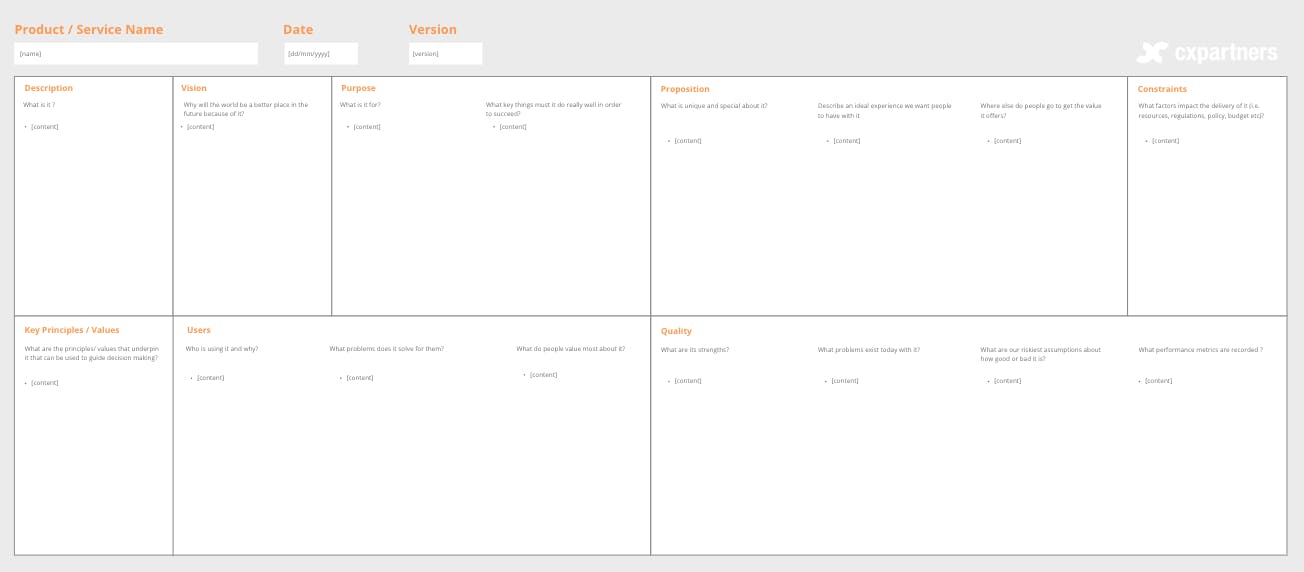Use this canvas to help shape your strategy
You can’t work effectively on a product or service if you don’t have a clear understanding of what it’s for and what it’s trying to achieve.
Sounds like common sense doesn’t it, but do you feel absolutely clear on the strategy behind what you’re working on right now?
I definitely haven’t had clarity on many of the projects I’ve worked on over the years.
I’ve always found it hard to get clear and consistent answers to seemingly simple questions such as:
- What is this for?
- Why will the world be a better place in the future because it exists?
- What problems will it solve for the people who use it?
- What must it do well in order to succeed?
I’ve found that stakeholders agree on some answers, wildly disagree on others and probably contradict each other too!
The result of this strategic misalignment is that people end up working on the wrong problems and this results in a poor experience for your customer.
Classic symptoms of this are described by customers as their experience feeling disjointed, lacking focus, inconsistent’ and confusing’.
It is our job to do the hard work to make our customers' lives easier by getting answers to these key strategic questions as early as possible, communicating them to the team and reminding ourselves of them when we make our design decisions throughout our projects.
To make this easier I’ve created a Product / Service strategy canvas in Miro for you to use.

You should try to get answers to these questions as early as possible (kick off meetings and stakeholder interviews are perfect opportunities) because you can’t design a good solution if you don’t properly understand the problem.
I’d also recommend revisiting them throughout your projects to help everyone refocus on these fundamentals so put them somewhere where people will see them.
The questions to ask
This is a generic list so should be relevant to any product or service you may be working on, but you should add your own to suit your specific context too.
I’ve tried to keep them as ‘plain English’ as possible and would encourage you to record the answers is a similar format to give everyone the best chance of understanding them.
Description
What is it?
Vision
Why will the world be a better place in the future because of it?
Purpose
What is it for?
What key things must it do really well in order to succeed (i.e. make it easy to book an appointment with a doctor, ensure people can find contact details if they are in a crisis situation)
Key Principles & Values
What are the principles/ values that underpin it that can be used to guide decision making?
Users
Who is using it and why?
What do people value most about it?
What problems does it solve for them?
Proposition
What is unique and special about it?
Describe an ideal experience we want them to have with it
Where else do people go to get the value it offers?
Quality
What are its strengths?
What problems exist today with it?
What are our riskiest assumptions about how good or bad it is?
What performance metrics are recorded?
Constraints
What factors impact the delivery of it (i.e. resources, regulations, policy, budget etc)?
There’s really nothing more to it than that.
Pretty simple eh?
Strategy sounds complicated but doesn’t need to be.
How have I used this?
I used these questions to structure a strategy workshop for the FRANK drugs advice website.
I wanted everyone to discuss and agree on the answers to them before we started to plan how we might improve the website.
I was new to the team so had a go at filling out the canvas before the workshop based on what I’d already learned.
Having them pre-filled gave my client something to agree/ disagree which is always easier than staring at an empty page.
The session provoked some lively debate and generated some surprising answers to some big questions that really helped us to prioritise where we should invest our efforts into improving the service.
What should you do next?
Why not set up a session with your team with the simple objective of trying to get to a first draft of the answers to these critically important questions.
You’ll be amazed at what conversations they will generate that will be critically important to where you focus your efforts as a team and how you think about the product or service that you’re working on.
Once you’ve happy with it, put it somewhere that people will regularly see it, give it to new starters to get them on the right track and use it in design review meetings as a reminder of what you’re all there for.
Good luck and let me know how you get on with it!

